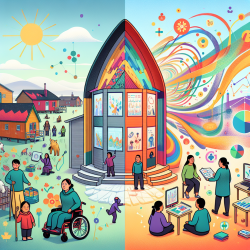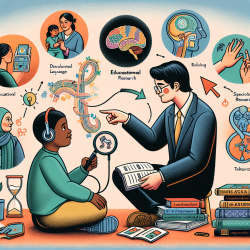Introduction
The development of rehabilitation services in Inuit communities presents unique challenges and opportunities. The research article "Development of Rehabilitation Services in an Inuit Sociocultural Context: Challenges, Strategies, and Considerations for the Future" offers a comprehensive analysis of these challenges and provides strategic insights for practitioners. This blog post will explore how speech-language pathologists and other rehabilitation professionals can leverage these findings to improve their practice and outcomes for children in Inuit communities.
Understanding the Context
Inuit communities face distinct health challenges, with a significant portion of the population experiencing health issues that require rehabilitation services. However, the delivery of these services is complicated by factors such as geographic isolation, cultural differences, and a lack of resources. The research highlights the importance of understanding the sociocultural context and adapting rehabilitation practices to meet the specific needs of Inuit populations.
Key Challenges and Strategies
The research identifies ten major themes of challenges faced by rehabilitation professionals in Inuit communities:
- Diverse clinical needs
- Communication issues
- Acquisition of cross-cultural interaction and population-specific knowledge
- Adaptation of clinical practice to Nunavimmiut
- Client engagement in rehabilitation
- Professional isolation
- Lack of awareness around the objectives and scope of rehabilitation practice
- Use of culturally safe assessment tools
- Staff turnover
- Large geographic area to be served
To address these challenges, the research suggests several strategies:
- Engaging in continuous cultural competency training
- Utilizing culturally safe assessment tools
- Fostering community involvement and collaboration
- Leveraging technology for remote consultations
- Building strong professional networks to mitigate isolation
Implementing Data-Driven Decisions
For speech-language pathologists, implementing data-driven decisions is crucial. By collecting and analyzing data on client outcomes, practitioners can tailor their approaches to better meet the needs of Inuit children. This includes using evidence-based practices and continuously evaluating the effectiveness of interventions.
Moreover, practitioners should advocate for more research into culturally appropriate assessment tools and intervention strategies. By contributing to the body of knowledge, they can help develop more effective rehabilitation services that are sensitive to the cultural context of Inuit communities.
Encouraging Further Research
While the research provides valuable insights, there is still much to learn about providing effective rehabilitation services in Inuit communities. Practitioners are encouraged to engage in further research and collaboration with Indigenous communities to develop innovative solutions that address the unique challenges faced by these populations.
Conclusion
Improving rehabilitation outcomes for children in Inuit communities requires a commitment to understanding the cultural context and implementing data-driven practices. By leveraging the strategies outlined in the research, speech-language pathologists and other rehabilitation professionals can enhance the quality and effectiveness of their services, ultimately leading to better outcomes for children.
To read the original research paper, please follow this link: Development of rehabilitation services in an Inuit sociocultural context: challenges, strategies and considerations for the future.










